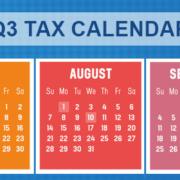Weathering the storm of rising inflation
Like a slowly gathering storm, inflation has gone from dark clouds on the horizon to a noticeable downpour on both the U.S. and global economies. Is it time for business owners to panic?
Not at all. As of this writing, a full-blown recession is possible but not an absolute certainty. And the impact of inflation itself will vary depending on your industry and the financial strength of your company. Here are some important points to keep in mind during this difficult time.
Government response
For starters, don’t expect any dramatic moves by the federal government. Some smaller steps, however, have been taken.
For instance, the Federal Reserve has raised interest rates to “pump the brakes” on the U.S. economy. And the IRS recently announced an increase in the optional standard mileage rate tax deduction for the last six months of 2022 (July 1 through December 31). The rate for business travel is now 62.5 cents per mile — up from 58.5 cents per mile for the first half of 2022.
This is notable because the IRS usually adjusts mileage rates only once annually at year-end. The tax agency explained: “in recognition of recent gasoline price increases, [we’ve] made this special adjustment for the final months of 2022.”
Otherwise, major tax relief this year is highly unlikely. Some tax breaks are inflation-adjusted — for example, the Section 179 depreciation deduction. However, these amounts were calculated at the end of 2021, so they probably won’t keep up with 2022 inflation. What’s more, many other parts of the tax code aren’t indexed for inflation.
Strategic moves
So, what can you do? First, approach price increases thoughtfully. When inflation strikes, raising your prices might seem unavoidable. After all, if suppliers are charging you more, your profit margin narrows — and the risk of a cash flow crisis goes way up. Just be sure to adjust prices carefully with a close eye on the competition.
Second, take a hard look at your budget and see whether you can reduce or eliminate nonessential expenses. Inflationary times lead many business owners to try to run their companies as leanly as possible. In fact, if you can cut enough costs, you might not need to raise prices much, if at all — a competitive advantage in today’s environment.
Last, consider the bold strategy of taking a growth-oriented approach in response to inflation. That’s right; if you’re in a strong enough cash position, your business could increase its investments in marketing and production to generate more revenue and outpace price escalations. This is a “high risk, high reward” move, however.
Optimal moves
Again, the optimal moves for your company will depend on a multitude of factors related to your industry, size, mission and market. One thing’s for sure: Inflation to some degree is inevitable. Let’s hope it doesn’t get out of control. We can help you generate, organize and analyze the financial information you need to make sound business decisions.
© 2022












